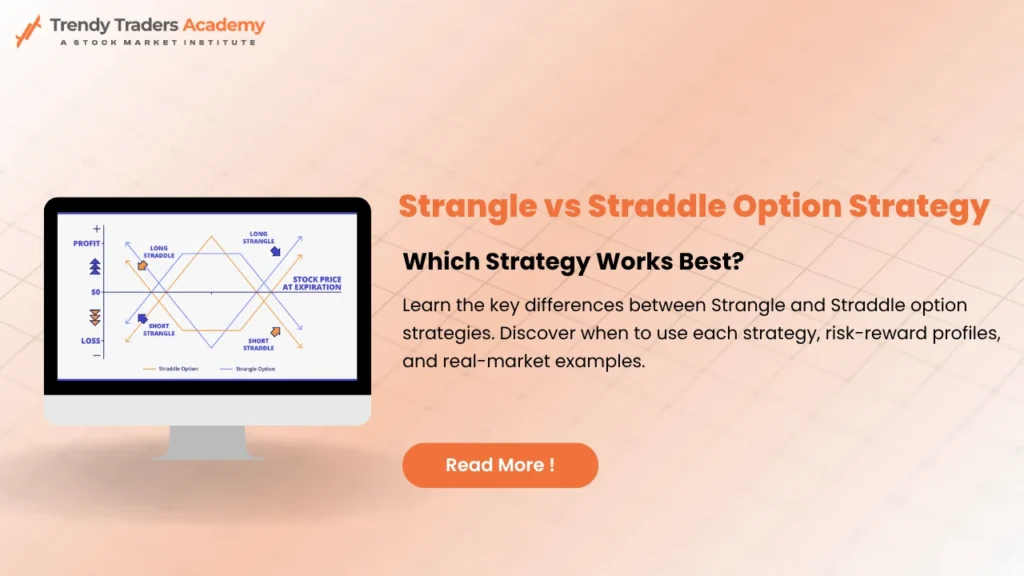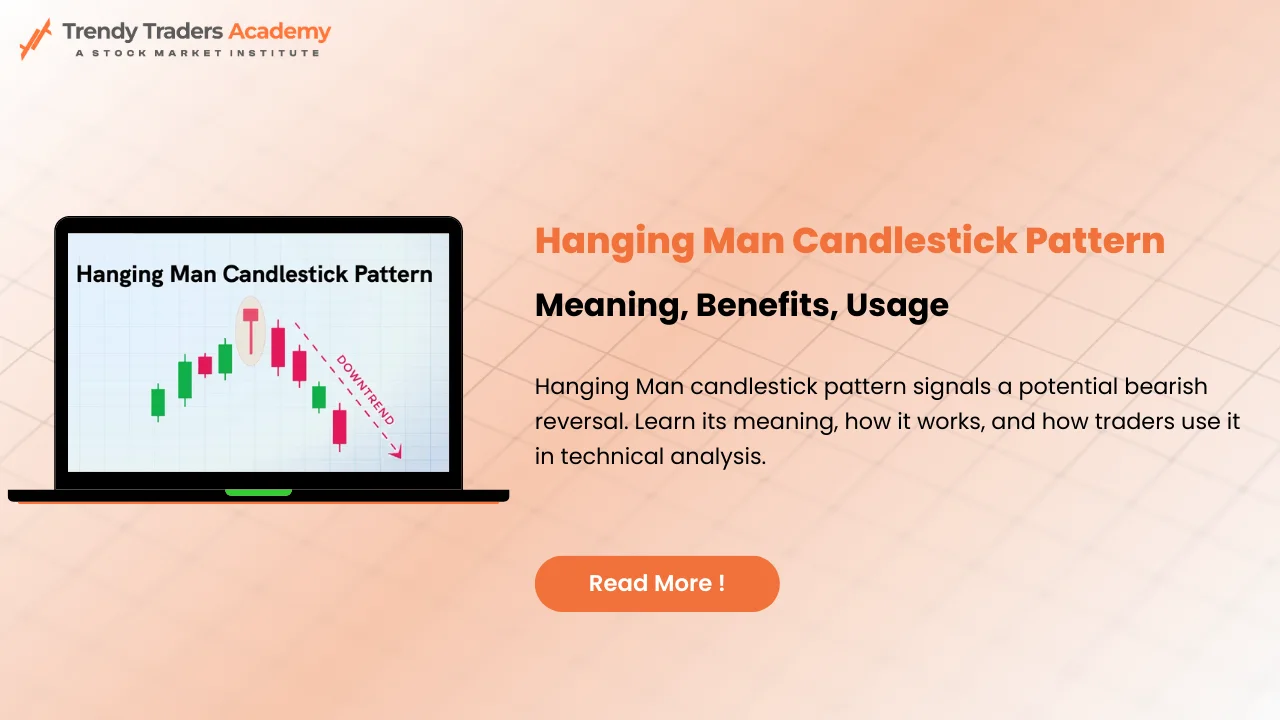
Strangle vs Straddle Option Strategy: A Beginner-Friendly Guide
When it comes to options trading, two popular strategies often confuse beginners—strangle and straddle. Both are used when traders expect a big price movement, but they aren’t sure in which direction. If you’ve ever wondered about the strangle vs straddle option strategy, you’re in the right place.
This blog breaks down both strategies in a simple way, compares them side-by-side, and helps you understand when and why traders use them.
What is Options Trading?
Before we dive into a range of strategies, lest quickly go through options. An option is a contract that gives one the right, but not the obligation, to buy or sell a stock at a certain price point before a set date.
There are two types:
- Call Option – The right to buy
- Put Option – The right to sell
Now, let’s get into the actual strategies.
What is a Straddle Strategy?
A straddle strategy is used when a trader thinks a stock will move a lot, but isn’t sure if it will go up or down.
How it works:
You buy a call and a put option with the same strike price and the same expiry date.
Example:
Let’s say you choose Reliance stock, currently trading at ₹2500.
You buy a call option at ₹2500
You buy a put option at ₹2500
If the stock moves sharply—either up to ₹2700 or down to ₹2300—you make a profit. If the stock stays near ₹2500, you might lose the premium paid.
Pros:
Simple setup
Profits from large movement in any direction
Cons:
Needs a big move to cover both premiums
- Expensive due to high premiums
What is a Strangle Strategy?
A strangle strategy is also used when you expect high volatility but want to reduce your cost.
How it works:
You buy a call and a put option, but with different strike prices (usually out of the money) and the same expiry date.
Example:
Using the same Reliance stock at ₹2500:
Buy a call option at ₹2600
Buy a put option at ₹2400
Now, your cost (premium) is lower because both options are cheaper. But the stock needs to move beyond ₹2600 or below ₹2400 to be profitable.
Pros:
Cheaper than a straddle
Also benefits from big moves
Cons:
Stock needs to move even more for profits
Slightly more complex to manage
Side-by-Side Comparison: Strangle vs Straddle Option Strategy
Feature | Straddle Strategy | Strangle Strategy |
Strike Prices | Same | Different (OTM) |
Cost (Premiums) | Higher | Lower |
Break-even Point | Closer to current price | Farther from current price |
Profit Potential | Unlimited on big moves | Unlimited on bigger moves |
Ideal for | Big news events or earnings announcements | High volatility with cost sensitivity |
Risk | Limited to total premium paid | Limited to total premium paid |
When to Use a Straddle Strategy
Before earnings reports
When a big market announcement is expected
If you believe the stock will move a lot, but direction is unknown
Example:
- Before Infosys results, you expect strong movement but are unsure if the market will react positively or negatively.
- Using a straddle strategy, you buy both a ₹1500 call and put. If the stock moves to ₹1600 or ₹1400, you profit.
When to Use a Strangle Strategy
During high volatility, but you want lower cost
When the stock is range-bound and you expect a breakout
Budget-friendly way to play big moves
Example:
Tata Motors is at ₹700. You buy a call at ₹740 and a put at ₹660. The cost is less than a straddle, but the stock needs to move more to be profitable.
How to Calculate Break-Even Points
Let’s break this down using a real-world example.
For Straddle:
Stock: ₹2500
Premium: ₹100 (call) + ₹100 (put) = ₹200
Break-even Upside: ₹2500 + ₹200 = ₹2700
Break-even Downside: ₹2500 – ₹200 = ₹2300
For Strangle:
Strike Prices: ₹2600 (call), ₹2400 (put)
Premiums: ₹50 each = ₹100
Break-even Upside: ₹2600 + ₹100 = ₹2700
Break-even Downside: ₹2400 – ₹100 = ₹2300
Both need significant moves, but the strangle strategy needs even larger movement to be profitable.
Straddle vs Strangle in Real Market Conditions
Use a Straddle When:
The stock is near a strong support or resistance level
You expect a sudden breakout due to an external event
You’re okay with higher upfront cost
Use a Strangle When:
You want a cheaper setup
You’re targeting highly volatile stocks
You’re trading before events but expect a delay in price reaction
Pros and Cons: Quick Recap
Straddle Strategy:
Pros
Simpler setup
Works if stock moves sharply in any direction
Cons
Higher premium cost
Needs quicker movement to avoid loss
Strangle Strategy:
Pros
Less expensive
Same unlimited upside potential
Cons
Needs even larger movement
Risk of loss if stock stays within the strike range
Final Thoughts: Choosing Between Straddle vs Strangle Option Strategy
The key difference in the straddle vs strangle option strategy lies in cost and how far the stock must move. A straddle is like buying insurance for big, quick moves—it costs more but reacts faster. A strangle strategy is more affordable, but you need to wait for a bigger push.
No strategy is one-size-fits-all. Choose based on:
- Your budget
- The stock’s volatility
- Upcoming events
- Risk comfort
One must always keep in mind—options trading carries a lot of risk. One can use tools, platform backtesting, and proper position sizing to remain safe and do proper option trading.
Key Takeaways
- A straddle strategy involves buying a call and put with the same strike price
- A strangle strategy uses different strike prices, making it cheaper
- Both aim to get gains from big movements, regardless of direction or trend in which the market is moving
- One must choose the strategy based on market conditions, volatility, and your risk appetite.
Also Read : 5+ Types of Doji Candles Explained with Examples
FAQ'S
Which is better — a straddle or a strangle strategy?
It depends on your risk appetite. If you’re okay with paying a higher premium and want a better chance of profit with a smaller move, go for a straddle strategy. If you want a cheaper setup and can wait for a bigger move, the strangle strategy makes sense.
Can beginners use these strategies?
Yes, but it’s important to understand that both involve limited risk (the premium you pay), but require good timing and market analysis. Start small and test in paper trading if you’re new.
Do these strategies work for all stocks?
Not really. They work best for stocks that are known for high volatility or are expected to react to major news. Avoid using these on low-volume or slow-moving stocks.
How long should I hold a straddle or strangle?
Most traders use these just before a big event and close them soon after. Holding them too long may result in time decay, especially if the stock doesn’t move as expected.










